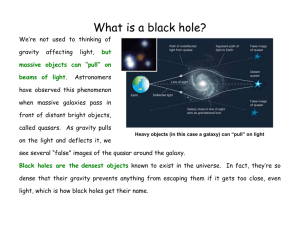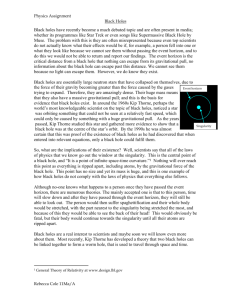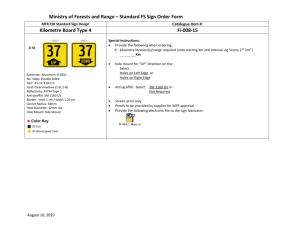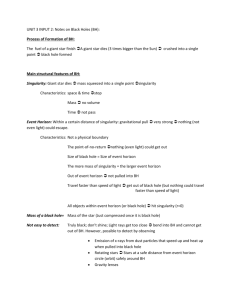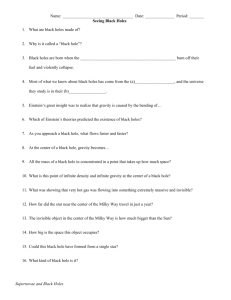Non-technical introduction
advertisement
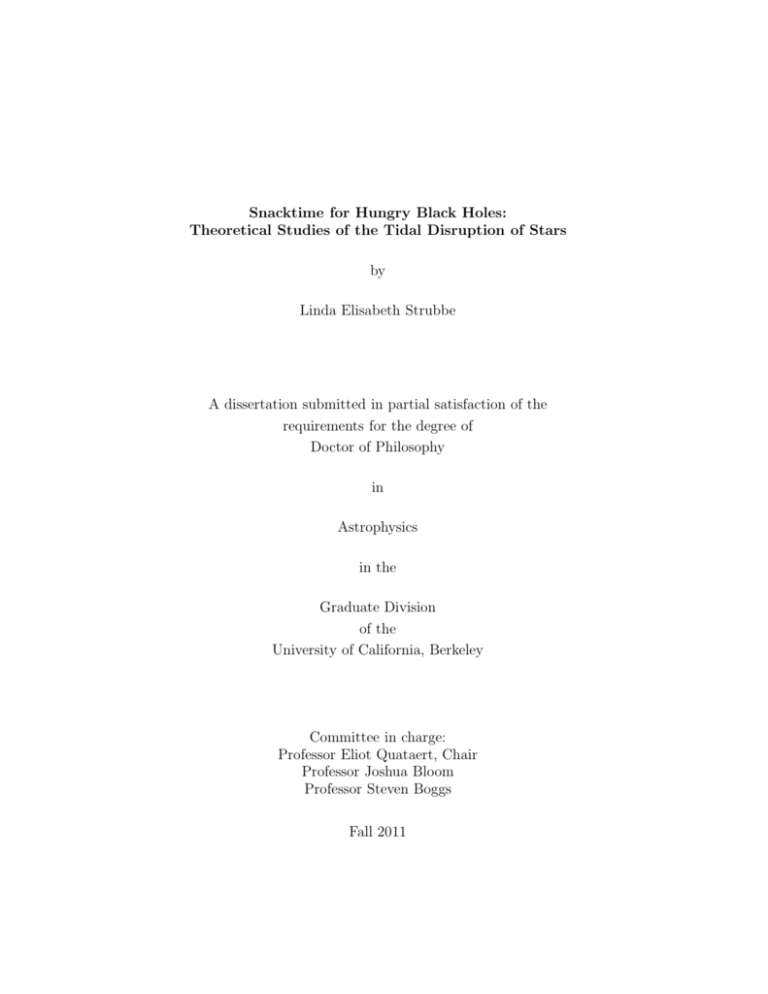
Snacktime for Hungry Black Holes: Theoretical Studies of the Tidal Disruption of Stars by Linda Elisabeth Strubbe A dissertation submitted in partial satisfaction of the requirements for the degree of Doctor of Philosophy in Astrophysics in the Graduate Division of the University of California, Berkeley Committee in charge: Professor Eliot Quataert, Chair Professor Joshua Bloom Professor Steven Boggs Fall 2011 1 Chapter 1 Introduction 1.1 Overview: for non-scientists and scientists Little did the star know, this was going to be its final orbit, ever. The star was just an ordinary star, several billion years old, very similar to our sun, in the central region of an ordinary galaxy similar to our own Milky Way. Only recently, small gravitational jostlings from other stars in the neighborhood had succeeded in nudging this star’s orbit into the danger zone surrounding the mighty black hole at the galaxy’s center. For its final year, the star hurtled towards the black hole at close to the speed of light—feeling the black hole’s gravity ever more intensely as the distance from the black hole diminished—until it arrived at a spot no further from the black hole than our sun is from us here on earth: the edge of the danger zone. As the star reached that spot, the difference in the black hole’s gravity between the opposite sides of the star (nearest and furthest from the black hole) overwhelmed even the star’s own gravity that had been holding the star together. The outer layers of the star began to be ripped off, then stellar layers deeper and deeper inside, until there was no longer any star at all—only a long stream of stellar gas stretching around the black hole. Stellar gas now flowed swiftly towards the black hole. As the high-speed flow funneled in, gas particles collided with each other, heating the gas to enormous temperatures and releasing immense amounts of energy. Some stellar gas was pushed back out and away from the black hole by that extreme release of energy. The remaining gas closely circled the black hole, the circular path shrinking and shrinking like water spiraling down a drain, until gas started spilling over the black hole’s edge. This gas released yet more energy as neighboring parcels of gas rubbed past each other, like rubbing your hands together to warm them on a chilly day. All in all, so much energy was released so quickly that for several weeks, the region around the black hole lit up almost as bright as the entire galaxy, 100 billion times as bright as the star had ever shone during its lifetime. Section 1.1. Overview: for non-scientists and scientists 2 This is the story of the tidal disruption of a star—a dramatic astronomical firework that has the potential to reveal secrets about giant black holes and the inner workings of galaxies.1 Just about every galaxy in the Universe—ours included—is thought to house a giant black hole in its center. A black hole is a creature so incredibly dense that even light can’t escape from it, so it looks black. We understand reasonably well how fairly small black holes form—stars at the end of their lives run out of fuel and can collapse under their own gravity—but there are major questions about how the giant black holes in the centers of galaxies came about. The overall idea is that black holes form small but then grow over time by eating nearby stuff in the galaxy: stuff like stars or gas, but mostly gas. An important point is that when black holes eat, their meal heats up and shines very brightly, just before they swallow it. Seeing the light from feasting black holes gives us a way of learning about how black holes eat and grow. Black holes probably feast the most when two galaxies crash into each other and merge into one: gas trajectories in the merging galaxy are thrown into disarray, and so some of the gas ends up flying right into the black hole. The details of how all of this works, though, are not yet understood very well. One path to understanding this better is to watch closely while a black hole eats a star— a mini-version of a black hole gorging on a galaxy’s worth of gas. If a star’s orbit carries it too close to the black hole, the black hole’s gravity rips it apart, sending some of the star’s gas down into the black hole. Just like bigger meals, the star’s gas should shine brightly as the black hole eats it, and so we should be able to see it. Unfortunately, telescope surveys of the sky haven’t been able to find many of these events so far, because the telescopes and cameras haven’t been powerful enough. But now, with new technology, several new powerful, fast-paced surveys are starting up. There’s a twist though: while everyone thought stellar meals would be so hot that they’d shine at X-ray wavelengths, these new surveys are at optical wavelengths (the kind of light we see with our eyes). Will the new surveys be able to find black holes eating stars? My thesis work says that they will. I have made theoretical calculations to predict what it should look like when a black hole eats a star: how bright it should be, how long the brightness should last, what color it should be, and what the spectrum should look like (when the light is passed through an instrument like a prism, to separate the light into different wavelengths). I made these calculations by building on previous work. Earlier studies used simple physics to theorize how quickly stellar gas is fed to the black hole. Many other studies have investigated black holes eating gas in other situations—small, medium and large black holes eating gas quickly or slowly. The process is actually extremely complicated: magnetic fields are created that help the gas drain into the black hole, while all that light created when the gas heats up can push the gas around. Astronomers observe black holes eating, create models to explain what they see, use the models to make predictions, test the predictions by observing more black holes, refine the models, etc., improving our understanding all the time. I adapted some of these results to the situation of a black hole eating a star, and 1 To keep this section uncluttered, I’m refraining from giving references here; the technical introductory sections §§1.2 and 1.3 contain references for the ideas and work mentioned here. Section 1.1. Overview: for non-scientists and scientists 3 used them to predict what we’ll see. Many of my calculations are simple—I can just write down a few equations on a piece of paper—which makes them easier to understand than complicated work on a computer. The art, though, lies in choosing the correct equations: they’re simple because they capture only the most important physics—which means I have to make sure I have a good idea of what’s important and what’s not, so I don’t end up leaving out something important. One of the most significant conclusions of my thesis is that, as I mentioned, these new optical surveys have the potential to find lots of black holes eating stars. They could find hundreds, compared with the handful we know about today. The reason is that after a star is disrupted, its gas flows very quickly towards the black hole, heating up a lot and creating lots of photons (particles of light). Photons can actually push back on gas particles, like hurling tennis balls up at falling balloons, so that much of the star’s gas is blown back out from the black hole. (It’s not an explosion, but you can picture the gas expanding out from the black hole in all directions kind of like that.) Because the gas is now fairly far from the black hole, it’s cooler in temperature than was previously thought, which means it shines in optical light, not (just) X-rays. They shine very brightly, too—almost as bright as a whole galaxy! And they appear and disappear on very human timescales (unusual for astronomy), lasting a few days up to a few weeks. Along the way, I also made calculations about how often we should expect black holes to eat stars. Many people have studied this question before, but my work takes a different slant: I wondered how often stars approach very close to the black hole on their last fateful orbits, versus how often stars are only just torn apart as they graze the edge of the black hole’s disruption zone. My earlier work showed that we should be able to tell the difference between these two scenarios when we watch a star get eaten, because the former is more violent. I concluded that the violent events are significantly less frequent than the gentler ones. Another part of my research—unrelated to black holes eating stars—was studying a disk of dust around a young star. The dust is probably created when rocks—baby planets— collide as they orbit the star. I explained why we see the dust arranged the way it is, helping give us a foundation for using disks like this to improve our understanding of how planets form. Back to black holes eating stars. Excitingly, after I published my first results a couple of years ago, candidate black-holes-eating-stars have been identified using optical data for the very first time! And the way these events look is quite consistent with my predictions. These surveys are just getting underway, and are likely to find many more events soon, giving us the chance to study black holes eating stars in far greater detail than ever before. Stars may be just a little snack for a huge black hole, but learning about how black holes eat these morsels will teach us about how black holes eat when a flood of gas comes their way—say, when two galaxies merge together. Ultimately, my work will help us understand better how black holes in the centers of galaxies—including the center of our own Milky Way—grew up from baby black holes all the way into giants.

